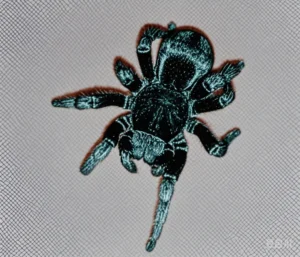Tarantula Science
Molecular Analysis of Grammostola pulchra Venom: Proteins and Potential Medicinal Uses
Introduction: A Complex Cocktail
Tarantula venom, including that of *Grammostola pulchra*, is a complex mixture of bioactive molecules primarily evolved to immobilize and predigest prey, typically insects and other arthropods. While often feared, the venom of most New World species like *G. pulchra* is not considered medically significant to humans. However, the intricate blend of proteins and peptides within this venom holds significant interest for scientific research, potentially harboring compounds with therapeutic applications.
General Composition of Tarantula Venom
Tarantula venoms are sophisticated biochemical arsenals. Common components include:
- Peptides and Small Proteins: These are often the most abundant and pharmacologically active components. Many function as neurotoxins, targeting ion channels (like sodium, potassium, and calcium channels) in the nervous system of prey, leading to paralysis.
- Enzymes: Components like hyaluronidase help spread the venom through tissues, while proteases begin the process of breaking down prey tissues (predigestion).
- Other Molecules: Amines, nucleotides, and other organic molecules contribute to the venom’s overall effect.
The exact composition varies significantly between tarantula species, reflecting their evolutionary history and ecological niche.
Key Components and Their Potential
The neurotoxic peptides are of particular interest to researchers. Because they often target specific ion channels with high affinity and selectivity, they can be valuable tools for studying nerve function. Some peptides isolated from various spider venoms (Wikipedia: Spider venom) have shown potential in areas like:
- Pain Research: Targeting specific pain pathways.
- Neurodegenerative Diseases: Modulating ion channels involved in conditions like epilepsy or stroke.
- Cardiovascular Applications: Affecting channels involved in heart rhythm or blood pressure.
- Bioinsecticides: Developing environmentally safer pesticides that target insect-specific channels.

Research on Grammostola Venom
While venom research has extensively studied some tarantula genera (like *Theraphosa* or certain Australian species), specific, in-depth molecular analysis of *Grammostola pulchra* venom might be less comprehensive compared to others. However, studies on the venom of other *Grammostola* species (like *G. rosea* / *G. porteri*) have identified various toxins, primarily targeting ion channels. It is highly likely that *G. pulchra* venom contains similar families of peptides, though the exact sequences and proportions would be unique.
Ongoing tarantula venom research peptides continues to uncover novel compounds across many species.
Potential Medicinal Uses (General Principles)
It is crucial to understand that finding a potentially useful peptide in venom is just the first step. No approved medicines are currently derived directly from *G. pulchra* venom. However, the principles are:
- Isolation and Characterization: Identifying specific peptides in the venom.
- Synthesis: Creating synthetic versions of promising peptides.
- Testing: Rigorous preclinical and clinical trials to evaluate efficacy, safety, and side effects.
- Modification: Often, natural peptides need modification to improve stability, reduce toxicity, or enhance targeting for therapeutic use.
Venom-derived drug discovery is a long and complex process. While *G. pulchra* venom contributes to the vast library of natural compounds, specific breakthroughs directly linked to it are not currently established in clinical practice.
Mild Venom, Rich Chemistry: Even though the venom is mild to humans, the complexity of its molecular makeup makes it a valuable subject for biochemical and pharmacological research.
Challenges and Future Directions
Challenges include obtaining sufficient venom quantities for analysis, the complexity of separating and identifying individual components, and the extensive testing required for drug development. Future research using advanced techniques like transcriptomics (studying the genes expressed in venom glands) and proteomics (analyzing the proteins directly) will continue to shed light on the composition of *G. pulchra* venom and its potential hidden treasures.
Information based on general principles of venom research and pharmacology. Specific data on G. pulchra venom requires reference to specialized scientific literature.










